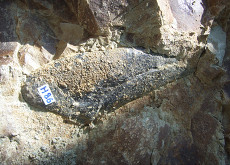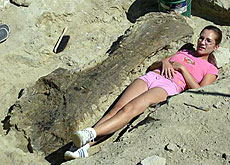Swiss banker stumbles upon dinosaur graveyard

Roland Ottiger works as an internal auditor at a Zurich bank, evaluating business practices and poring over figures. In his spare time he collects fossils.
He recently hit the headlines in Switzerland after stumbling upon the bones of two Plateosaurus, unearthing what may turn out to be Europe’s largest dinosaur graveyard.
“After 30 years as a fossil collector it was truly exhilarating to come across such a dinosaur. It’s not normally possible for an amateur palaeontologist – it was pure luck,” he told swissinfo.
Ottiger chanced upon the remains of the two dinosaurs at a building site in the small town of Frick in northern Switzerland, while returning from a business trip to Germany in May.
“I saw the building site from the train window and out of curiosity stopped off on the way back to take a better look,” he explained.
“I always pay attention when passing Frick as it’s known as a region rich in fossils, especially at building sites.”
His keen eyes initially spotted several bones at the rear of the site, before realising that one of the muddy walls of the site was encrusted with dinosaur remains.
In all, over 300 bones of a complete skeleton as well as hands and legs belonging to two Plateosaurus ten metres apart were uncovered at the site.
Land of the giants
But Ottiger’s find has much wider implications. The latest discovery follows closely on the heels of two other dinosaurs which were recently unearthed in the small town near Basel.
Ben Pabst, a lead researcher from the Aathal Dinosaur Museum outside Zurich, said that subsequent excavations in Frick showed that Ottiger had happened upon part of the biggest dinosaur grave in Europe.
“From the Atlantic Ocean to the Ural Mountains, Frick is the most important dinosaur site in Europe. Almost every ten metres you dig you come across a dinosaur. This concentration of skeletons is unique,” said Pabst.
This was confirmed by Martin Sander, a dinosaur paleontologist at Bonn University in Germany, also taking part in the excavations alongside scientists from the Dutch National Museum of Natural History in Leiden.
“It could be that the area extends for 2.5 kilometres and in that case, you could certainly say it’s the biggest site in Europe,” said Sander.
The Frick area contained the bones of one animal per 100 square metres, Sander said, so the entire area might contain bones of 100 more Plateosaurus.
Plant-eating “flat lizards”
The Plateosaurus was a peaceful herbivore that roamed river deltas in large herds some 210 million years ago, the last Triassic period, when most of Switzerland was covered with desert and its landscape may have looked much like the estuary of the Nile now.
“It’s thought that the large dinosaurs, weighing up to three tons, got trapped and died in the marshes around Frick,” explained Ottiger.
The Plateosaurus was the first really big dinosaur – up to ten metres long and four metres high. It had a small skull and long neck and each forelimb had a pointed thumb claw, probably for feeding and defending itself.
There are two other large Plateosaurus sites in southern Germany. It is not known how big they are because one is covered by the town of Halberstadt and the other, near Trossingen, by a forest.
But thanks to the Swiss banker, Switzerland also has its own resting place for the plant-eating giants.
“If I hadn’t seen the building site I wouldn’t have gone there and three weeks later it would have been inaccessible and a new family house would be standing there,” joked Ottiger.
swissinfo, Simon Bradley
Dinosaurs dominated the earth for over 160 million years, first appearing 230 million years ago. They died out 65 million years ago.
The first dinosaur fossil to be discovered in mainland Europe was of a Plateosaurus or “flat lizard”, which was found in southern Germany in 1837.
Plateosaurus is one of the most common dinosaur fossils discovered on the continent in over 50 locations.
The plant-eating Plateosaurus lived around 216 to 199 million years ago. It was the first really big dinosaur – up to ten metres long and four metres high.
Plateosaurus were bulky bipedal herbivores, which had a small skull on a long neck, sharp teeth, long tail, powerful limbs, and a large thumb spike on each “hand” probably used for defence and feeding.
Plateosaurus and the other prosauropods were the first dinosaur group to feed exclusively on vegetation and were the first animals on Earth to evolve the ability to feed on relatively high vegetation. Until their appearance all herbivores had been squat, short-necked animals incapable of reaching high foliage.
Owing to the find of a “knucklebone” in a drillcore at the North Sea, 2,256 metres below the seafloor, Plateosaurus is known as the “World’s deepest dinosaur”.

In compliance with the JTI standards
More: SWI swissinfo.ch certified by the Journalism Trust Initiative













You can find an overview of ongoing debates with our journalists here . Please join us!
If you want to start a conversation about a topic raised in this article or want to report factual errors, email us at english@swissinfo.ch.